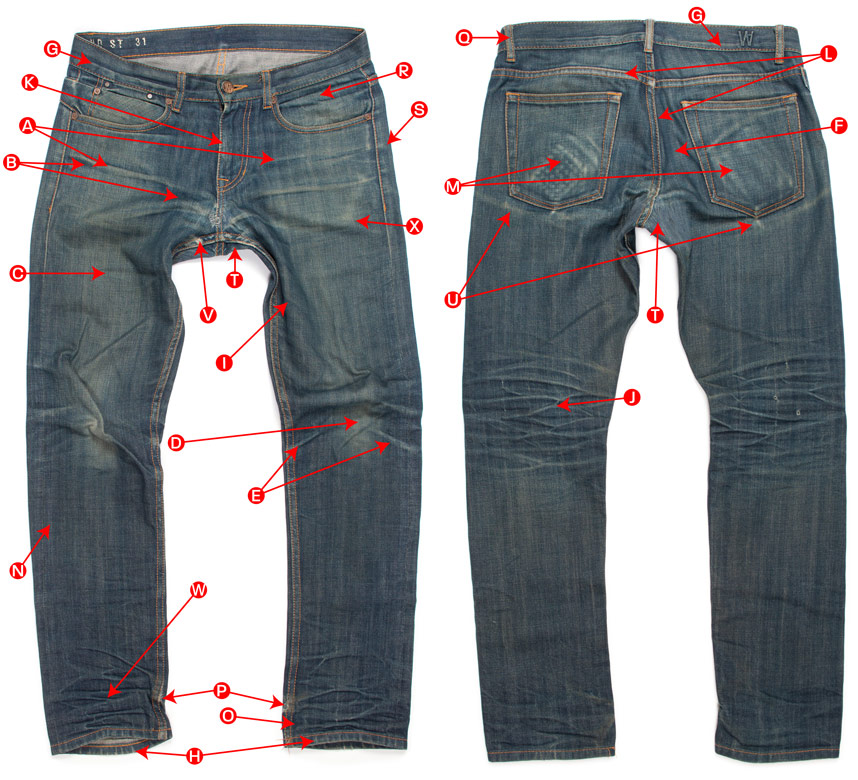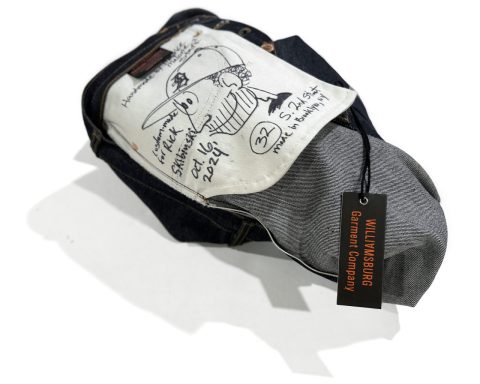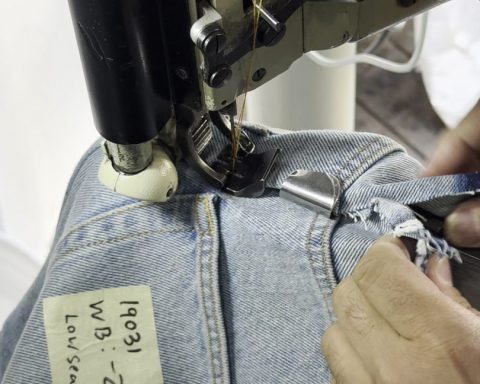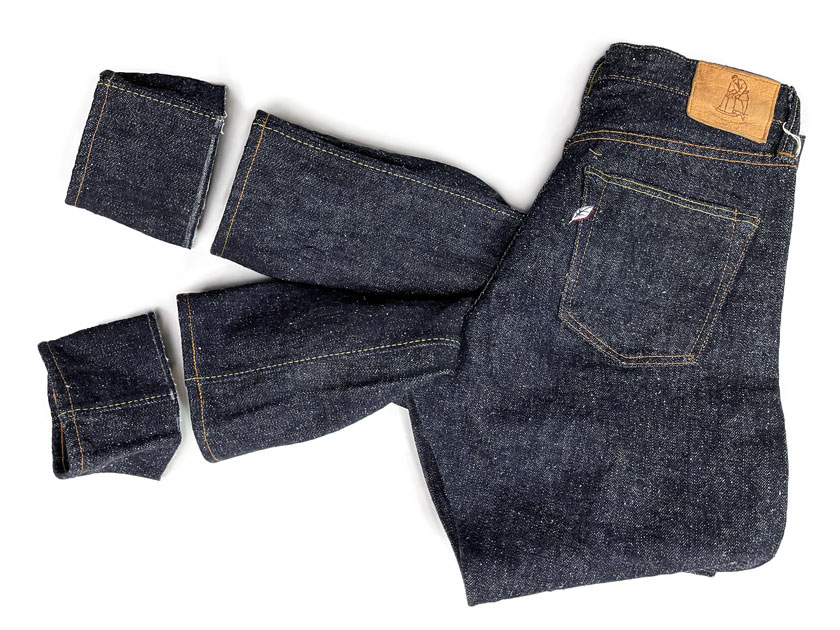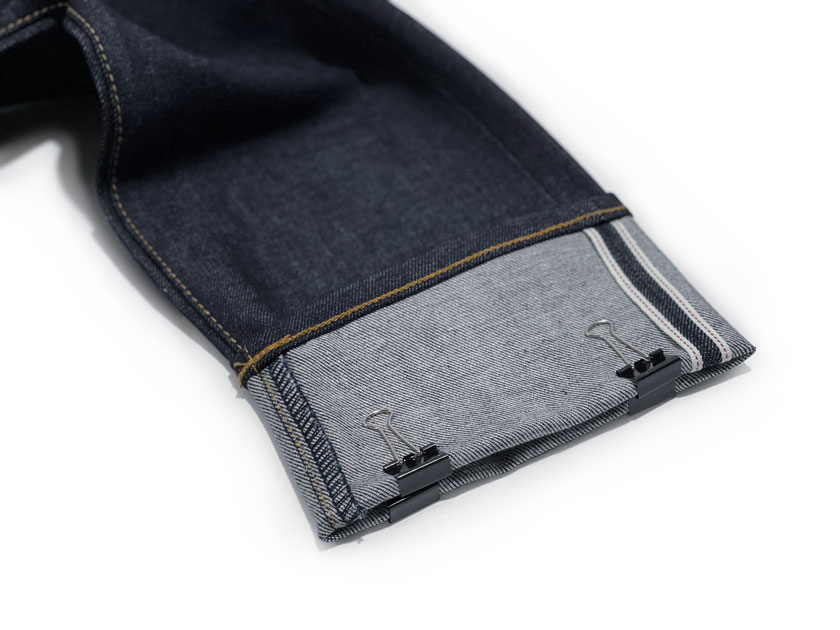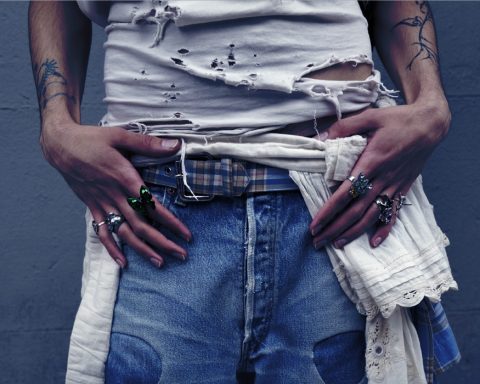As a denim designer, I researched the causes and consequences of denim fading like a scientist to aggressively imitate real-world denim aging in my pre-washed jeans designs. This guide is a great tool for understanding how to create the various fading effects that develop on jeans for those looking for tips on “how to fade jeans” naturally. Here’s what I discovered.
A – Whiskers
Whiskers, also known as mustaches, hige, crease lines, are lines that naturally form along folds in the front hip area of jeans as a result of repetitive stretching and movement. With abrasion, the highest points of the folds fade the lightest in color. The denim fabric holds more color and appears darker as you move down the folds.
B – Whisker Texture
Highs and lows form around whiskers, giving them a texture. When denim is stretched and pulled around the hips at the front rise, dark patches form. There are lighter areas (whisker lines) where the color has been worn off by friction.
C – Thigh Fading
The indigo color in the denim yarns fades because of abrasion against the thighs. When we sit, our arms and hands rest on our thighs, which wears away the color.
D – Knee Fading
The knees are one of the most stressed areas in jeans. If you frequently work or perform tasks on your knees, they will rapidly fade.

E – Knee Stretch Marks
Knee stretching will happen along with fading. This is particularly noticeable in jeans made of raw denim that has naturally aged. Lines with high and low basins protrude like whiskers in the knee flexion direction.
F – Seat Fading
Each time a person sits in a pair of jeans, the seat fades slightly. This is the result of a small amount of color rubbing off the yarns, which lightens the overall appearance.
G – Waistband Fading
Belt-related friction is the most common cause of waistband wear and tear. Randomly, the seam line within the waistline becomes visible.
H – Hem Fading
Fading or destruction at the hem can occur in a variety of ways. Rope-like twisting fade lines will appear at the high points if the hem is sewn unevenly at the in-and-out seams. Shredding or fraying can occur over time when jeans are too long and drag on the ground.
I – Chevrons
Chevrons are the fade lines that appear on the inner thighs of jeans just above the inseam. Walking, squatting, and sitting can all stretch the inseam. Friction on the high points of the stretch lines rubs away the yarn color, resulting in chevrons.
J – Rear Knee Honeycombs
One of the most sought-after fadings among raw denim fans, the rear knee honeycombs, are the result of months or even years of natural aging. When fabric bends and collapses on itself on the back side of the knees, the high points fade from abrasion while the low points remain darker, creating a honeycomb appearance.
K – Fly Abrasion
The fading around the fly is a continuation of the whiskers and adheres to the same principles. The high points are abraded the most, while the lower areas remain darker. It’s worth noting that zippers and button-fly jeans fade in different ways. The spaces between the buttons on button-fly jeans facilitate the formation of high and low fading horizontally, which extends into the hips across the front rise, resulting in more detailed fade patterns. There are typically more vertical abrasion highlights on the zipper fly, which does not bend as easily.
L – Seat Seam Abrasion
On jeans, the seat and back pocket seams are high points that take a lot of abuse every time the wearer sits. The high points and edges of jeans deteriorate and fade the fastest in time.

M – Back Pocket / Wallet Fades
If you carry items in your rear pockets on a regular basis, such as wallets or phones, the color in the high spots of the denim will fade faster due to abrasion each time you sit on them.
N – Outseam Lines / Train Tracks
Due to their resemblance to railway tracks, the two faded lines that develop on either side of the outseams of jeans manufactured with selvedge edges or overlock seams that have been pressed open on the inside of the jeans are frequently referred to as “train tracks.” If the outside seams of the jeans are sewn together, these lines won’t show up.
O – Cuff Lines / Roll Creases
Depending on how you wear your long, rolled, or cuffed jeans, lines will appear differently. The bottom of the denim may become ragged or frayed if you roll them such that the length hits the ground. If the roll or cuff is high, a dark line may appear on the face of the denim from a lack of abrasion.
P – Inseam Abrasion
Because the inseam is a high point on jeans, they tend to wear faster from abrasion, especially in the crotch and at the hem, where there is a lot of friction. These highlighted high spots often get whiter and brighter with age than other regions of the jeans.
Q – Belt Loop Fading
Belt loops, like other elevated places, suffer a lot of abrasion damage. With aging, they wind up with fraying plus having some of the brighter white portions, particularly at the ends and center points.
R – Front Pocket Whiskers & Crease Lines
The aging process here is comparable to that of the whiskers around the thigh. The denim stretches as a result of sitting and walking, and the waistband compression exaggerates the peaks and valleys inside the hand pockets just below the waistline. The coin pocket suffers from wear and develops highlights on the coin pocket side.
S – Hip Whiskers
Hip whiskers extend from the middle of the front rise and wrap around the hip outseams before fading out on the back side, just past the seamline.
T – Crotch Fading / Blowout
Due to the continual rubbing of the fabric against fabric between the legs, the crotch of jeans sustains the most wear and tear. Complete crotch blowouts that result in crotch holes are influenced by the wearer’s body type, how high or low they wear their jeans, and the denim’s thickness (lighter weight textiles may blowout more quickly than heavy).
U – Seat Lines / Rear Crotch Whiskers
Because of the lower resistance and compression at the location where the fabric folds, subtle whiskers can emerge just below the back pockets. These lines originate from the crotch’s center point stress area.
V – Crotch Seam Damage
During normal wear, the elevated seams in the crotch receive the most abrasion from all of the rubbing inside the crotch and frequently acquire frayed edges, high contrast, and even tears.
W – Denim Stacks
Stacks on jeans occur when the length of the jeans is so long that the denim fabric buckles and crinkles, or stacks on top of itself. Over time, honeycombs form above the hem. The longer the excess length is at the inseam, the more and higher the stack forms over the leg opening.
X – Pocket Bag Fading
Abrasions on the thighs can cause fading over the pocket bag. The pocket’s outline, or high points, or items that stay in the pocket for an extended period of time can form outlines of their shapes.

